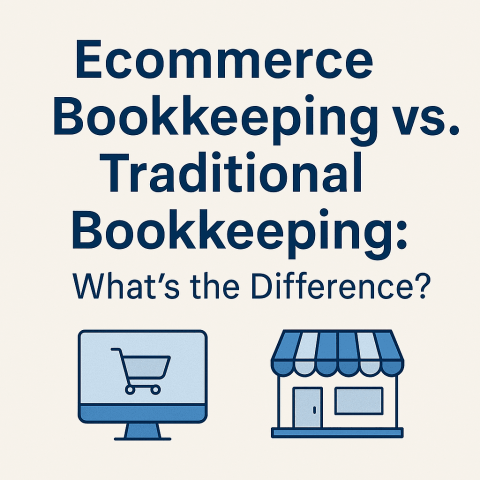
Do I Need to Report My Amazon Affiliate Earnings to HMRC?
April 2, 2025
Why Ecommerce Bookkeeping Matters in 2025
April 17, 2025In the evolving landscape of business finance, understanding the distinctions between e-commerce bookkeeping and traditional bookkeeping is crucial for entrepreneurs aiming to manage their financial records effectively. While both practices share the fundamental goal of accurately recording financial transactions, the methodologies and tools they employ differ significantly due to the nature of the businesses they serve.
What is Traditional Bookkeeping?
Traditional bookkeeping involves the systematic recording of a company’s financial transactions, such as sales, purchases, receipts, and payments, typically associated with brick-and-mortar businesses. This method often relies on manual processes or basic accounting software to track financial activities. Transactions are usually straightforward, involving direct interactions and physical documentation.
What is E-commerce Bookkeeping?
E-commerce bookkeeping pertains to the recording and management of financial transactions for businesses that operate online. This process encompasses tracking sales, expenses, and payments across various digital platforms, including websites, online marketplaces, and social media channels. Given the digital nature of e-commerce, bookkeeping in this context often utilizes specialized software to handle the complexities of online transactions.

Key Differences Between E-commerce and Traditional Bookkeeping
- Sales Channels and Revenue Recognition
- Traditional Bookkeeping: Focuses on sales from physical locations, with revenue recognized at the point of sale.
- E-commerce Bookkeeping: Manages sales across multiple online platforms, requiring tracking of transactions from various digital channels and recognizing revenue when orders are fulfilled.
- Payment Processing
- Traditional Bookkeeping: Deals with cash, checks, and card payments processed through point-of-sale systems.
- E-commerce Bookkeeping: Handles a variety of online payment methods, including credit cards, digital wallets, and third-party payment processors, necessitating reconciliation of payments received through different gateways.
- Inventory Management
- Traditional Bookkeeping: Involves tracking physical inventory stored on-site or in nearby warehouses, with relatively simple stock management processes.
- E-commerce Bookkeeping: Requires monitoring inventory across multiple warehouses or fulfillment centers, often in different regions or countries, adding complexity to stock management and valuation.
- Tax Compliance
- Traditional Bookkeeping: Entails adhering to local tax regulations based on the physical location of the business.
- E-commerce Bookkeeping: Must navigate tax obligations across various jurisdictions, including international sales taxes and VAT, due to the global reach of online sales.
- Transaction Volume and Data Management
- Traditional Bookkeeping: Typically manages a moderate volume of transactions with manual or semi-automated processes.
- E-commerce Bookkeeping: Handles a high volume of transactions, often necessitating advanced software solutions to automate data entry, categorization, and analysis.
Best Practices for E-commerce Bookkeeping
To effectively manage e-commerce bookkeeping, consider the following practices:
- Utilize Specialized Accounting Software: Implement software designed for e-commerce to automate transaction recording, inventory tracking, and financial reporting.
- Integrate Sales Platforms: Connect your accounting system with all online sales channels to ensure seamless data flow and accurate revenue tracking.
- Regular Reconciliation: Frequently reconcile accounts to verify that recorded transactions match bank statements and payment processor reports.
- Stay Informed on Tax Regulations: Keep abreast of tax laws in all regions where you conduct sales to ensure compliance and avoid penalties.
- Maintain Detailed Records: Organize and store all financial documents, including invoices, receipts, and tax filings, for accurate reporting and audits.
Conclusion
While traditional and e-commerce bookkeeping share the core objective of accurate financial record-keeping, the methods and tools differ due to the distinct nature of online business operations. E-commerce bookkeeping demands a more dynamic approach, leveraging technology to manage complex transactions, diverse sales channels, and multifaceted tax obligations. By understanding these differences and implementing best practices, e-commerce entrepreneurs can maintain robust financial health and ensure compliance in the digital marketplace.



